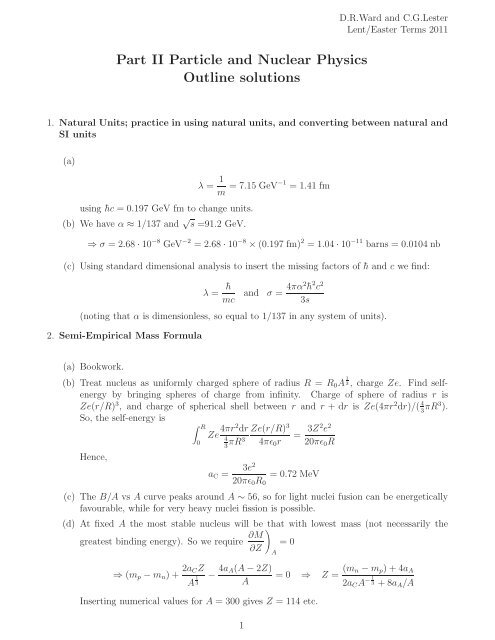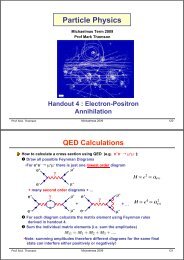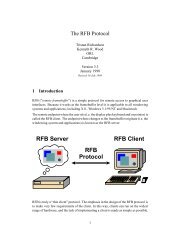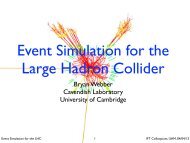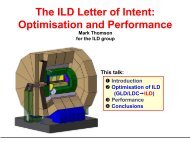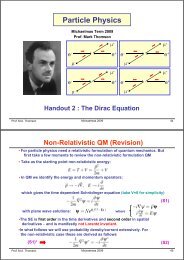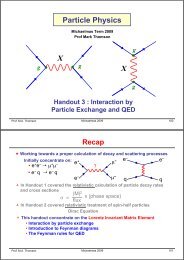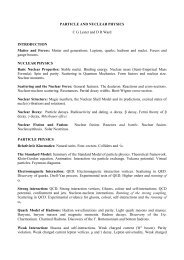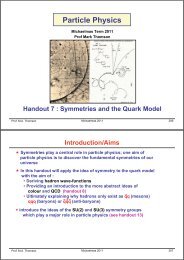Part II Particle and Nuclear Physics Outline solutions - High Energy ...
Part II Particle and Nuclear Physics Outline solutions - High Energy ...
Part II Particle and Nuclear Physics Outline solutions - High Energy ...
You also want an ePaper? Increase the reach of your titles
YUMPU automatically turns print PDFs into web optimized ePapers that Google loves.
<strong>Part</strong> <strong>II</strong> <strong>Part</strong>icle <strong>and</strong> <strong>Nuclear</strong> <strong>Physics</strong><br />
<strong>Outline</strong> <strong>solutions</strong><br />
D.R.Ward <strong>and</strong> C.G.Lester<br />
Lent/Easter Terms 2011<br />
1. Natural Units; practice in using natural units, <strong>and</strong> converting between natural <strong>and</strong><br />
SI units<br />
(a)<br />
λ = 1 m = 7.15 GeV−1 = 1.41 fm<br />
using ¯hc = 0.197 GeV fm to change units.<br />
(b) We have α ≈ 1/137 <strong>and</strong> √ s =91.2 GeV.<br />
⇒ σ = 2.68 · 10 −8 GeV −2 = 2.68 · 10 −8 × (0.197 fm) 2 = 1.04 · 10 −11 barns = 0.0104 nb<br />
(c) Using st<strong>and</strong>ard dimensional analysis to insert the missing factors of ¯h <strong>and</strong> c we find:<br />
λ = ¯h <strong>and</strong> σ = 4πα2¯h 2 c 2<br />
mc<br />
3s<br />
(noting that α is dimensionless, so equal to 1/137 in any system of units).<br />
2. Semi-Empirical Mass Formula<br />
(a) Bookwork.<br />
(b) Treat nucleus as uniformly charged sphere of radius R = R 0 A3, 1 charge Ze. Find selfenergy<br />
by bringing spheres of charge from infinity. Charge of sphere of radius r is<br />
Ze(r/R) 3 , <strong>and</strong> charge of spherical shell between r <strong>and</strong> r + dr is Ze(4πr 2 dr)/( 4 3 πR3 ).<br />
So, the self-energy is<br />
∫ R<br />
Hence,<br />
0<br />
Ze 4πr2 dr Ze(r/R) 3<br />
4<br />
3 πR3 4πǫ 0 r<br />
a C =<br />
= 3Z2 e 2<br />
20πǫ 0 R<br />
3e2<br />
20πǫ 0 R 0<br />
= 0.72 MeV<br />
(c) The B/A vs A curve peaks around A ∼ 56, so for light nuclei fusion can be energetically<br />
favourable, while for very heavy nuclei fission is possible.<br />
(d) At fixed A the most stable nucleus will be that with lowest mass (not necessarily the<br />
greatest binding energy). So we require ∂M )<br />
= 0<br />
∂Z<br />
⇒ (m p − m n ) + 2a CZ<br />
A 1 3<br />
− 4a A(A − 2Z)<br />
A<br />
Inserting numerical values for A = 300 gives Z = 114 etc.<br />
1<br />
A<br />
= 0 ⇒ Z = (m n − m p ) + 4a A<br />
2a C A −1 3 + 8a A /A
(e) By analogy with (b), <strong>and</strong> neglecting the proton-neutron mass difference, we have the<br />
gravitational p.e. given by:<br />
− 3GM2<br />
5R = −3Gm2 nA 2<br />
5R 0 A 1 3<br />
= −a G A 5 3 with a G = 3Gm2 n<br />
5R 0<br />
If neutrons only, N = A <strong>and</strong> Z = 0, so the binding energy reduces to<br />
B = a V N − a S N 2 3 − aA N + a G N 5 3<br />
= 5.8 · 10 −37 MeV<br />
which must be > 0 if the ”nucleus” is bound. The a S term is negligible, so we find<br />
N 2 3 > (a A − a V )/a G = 5 · 10 55 . So M > 8 · 10 28 kg which is 0.07 solar masses.<br />
3. The Fermi Gas model<br />
Density of states:<br />
Fermi energy is defined by<br />
g(ǫ) = BAǫ 1 2 where B = 4√ 2m 3 2R 3 0<br />
3π¯h 3<br />
N =<br />
∫ ǫF<br />
0<br />
g(ǫ)dǫ = 2 3 BAǫ3 2<br />
F ⇒ ǫ F =<br />
( ) 3N<br />
2 3<br />
2BA<br />
If N = Z = 1 A, neutrons <strong>and</strong> protons have the same Fermi energy<br />
2<br />
ǫ F =<br />
( ) 3A<br />
2 ( )2<br />
3 3 3<br />
= = 33.2 MeV<br />
4BA 4B<br />
(n.b. non-relativistic) <strong>and</strong> the corresponding Fermi momentum = √ 2mǫ F = 250 MeV/c.<br />
Total KE carried by the neutrons is<br />
∫ ǫF<br />
0<br />
Adding in the protons similarly, total KE is<br />
ǫg(ǫ)dǫ = 2 5 BAǫ5 2<br />
F = 2 ( ) 3N<br />
5 ( )2<br />
5 BA 3 3 3 3 5<br />
= N 3<br />
2BA 5 2BA<br />
( )2<br />
3 3 3 5 5<br />
(N 3 + Z 3 )<br />
5 2BA<br />
Writing N = 1A(1 + α) <strong>and</strong> Z = 1 A(1 − α) where α = (N − Z)/A, we can exp<strong>and</strong> to second<br />
2 2<br />
order in α<br />
( )<br />
(N 5 5 A 5 [<br />
3<br />
3 + Z 3 ) ≈<br />
2<br />
So the asymmetry term in the energy is<br />
(<br />
3 3<br />
)2<br />
5 2BA<br />
3 ( A<br />
2<br />
2 + 10<br />
9<br />
(N − Z) 2 ]<br />
A 2<br />
) 5 3 10 (N − Z) 2 (N − Z) 2<br />
≡ a<br />
9 A 2 A<br />
A<br />
from which we find, after a little algebra, a A = 1 3 ǫ F = 11 MeV. This is about half the fitted<br />
value for a A .<br />
Pairing energy ∼ 1/g(ǫ F ) in this model.<br />
g(ǫ F ) = BAǫ 1 2<br />
F = 3A<br />
4ǫ F<br />
2
so pairing energy ∼ 4ǫ F /3A ∼ 0.44 MeV, taking A = 100 <strong>and</strong> ǫ F = 33 MeV. For comparison,<br />
SEMF fit gives 33.5 MeV/A 3 4 ∼ 1 MeV. Again the Fermi gas model is smaller by about a<br />
factor of two, because it only takes account of KE, <strong>and</strong> not of any PE contribution, i.e. the<br />
inter-nucleon attraction.<br />
4. Practice in using cross-sections<br />
(a) Number of scattering centres per unit area = ρ/M A where ρ = 0.1 kg m −2 , <strong>and</strong> M A<br />
is the mass per nucleus. Rate of scattering = 10 5 (ρ/M A )σ = 688 s −1 (since the total<br />
cross-section σ = 270.01 b); transmitted intensity = 99312 s −1 .<br />
(b) Rate of fissions = 688 × (200/270.01) = 510 s −1 .<br />
(c) Total rate of elastic scattering = 688 × (0.01/270.01) = 0.0255 s −1 . Area of sphere at<br />
radius 10 m is 400π m 2 , so flux of neutrons = 0.0255/400π = 2 10 −5 s −1 m −2 .<br />
5. <strong>Nuclear</strong> sizes <strong>and</strong> Form Factors<br />
Start from<br />
∫<br />
F(q 2 ) =<br />
d 3 r e iq·r ρ(r)<br />
For the purpose of integration, take q as the polar axis, hence:<br />
F(q 2 ) =<br />
=<br />
∫<br />
2πd(cosθ ′ ) r 2 dr e iqr cos θ′ ρ(r)<br />
∫ [ ] e<br />
2πr 2 iqr cos θ ′ π<br />
drρ(r) = 4π ∫ ∞<br />
r sin qrρ(r)dr<br />
iqr q<br />
0<br />
0<br />
Then, for qr ≪ 1, exp<strong>and</strong> the sin keeping the first two terms:<br />
F(q 2 ) = 4π q<br />
∫ ∞<br />
0<br />
r<br />
[<br />
qr − (qr)3<br />
3!<br />
· · ·<br />
]<br />
ρ(r)dr = 1 − 1 6 q2 R 2 · · ·<br />
For a 200 MeV electron (ultrarelativistic) E = p = k in natural units, so k = 1.02 × 10 15 m −1 .<br />
q = 2k sin 1 2 θ = 1.95 × 1014 m −1 . So, given |F(q 2 )| 2 = 0.7 we obtain √ R 2 = 5 × 10 −15 m.<br />
Oscillatory structure in F(q 2 ) suggests non-smoothness in ρ(r), i.e. more like a top-hat than a<br />
Gaussian form (c.f. Fourier transforms of a Gaussian <strong>and</strong> a top-hat in 1D.) Best fit is a top-hat<br />
with rounded corners (e.g. a Fermi function).<br />
6. Mirror Nuclei<br />
The pair of mirror nuclei have (N, Z) = ( 1(A ± 1), 1 (A ∓ 1)). They have different Coulomb<br />
2 2<br />
energies;<br />
∆E C = a [ (A )<br />
C + 1 2 ( ) A − 1 2<br />
]<br />
− = a CA<br />
= 3αA<br />
A 1 3 2 2 A 1 3 5R<br />
using a C = 3e 2 /(20πǫ 0 R 0 ) = 3α/5R 0 <strong>and</strong> R = R 0 A 1 3. The only other terms which are differ in<br />
the SEMF between the mirror nuclei are Z(m p +m e )+(A−Z)m n , so M(A, Z +1)−M(A, Z) =<br />
2m e + E max = ∆E C + m p + m e − m n ⇒ ∆E C = E max + 1.8 MeV. Insert numbers to get the<br />
answers on the problem sheet. Find R/A 1 3 is reasonably constant, but higher than the usual<br />
value of R 0 .<br />
3
7. Scattering in <strong>Nuclear</strong> <strong>Physics</strong><br />
Born approximation is based on first order perturbation theory, so it is suitable when the<br />
potential is weak. In contrast, the partial wave method is general, but involves the calculation<br />
of an infinite number of partial waves. However, if the projectile’s energy is small enough,<br />
<strong>and</strong>/or the potential is sufficiently short range, so that kR ≪ 1, then only the l = 0 partial<br />
wave is significant in the neighbourhood of the potential, <strong>and</strong> the method is quite easy to apply.<br />
Of course, if the potential is also weak, then either approach is viable.<br />
The question doesn’t imply that V (r) is weak, but we are asked about the low energy limit, so<br />
the partial wave approach is the obvious choice. Wave functions are:<br />
√ √<br />
2m(V0 − E) 2mV0<br />
r < b ψ = A sinh qr where q =<br />
¯h 2 ≈<br />
¯h 2<br />
√<br />
2mE<br />
r > b ψ = B sin(kr + δ 0 ) where k =<br />
¯h 2<br />
Matching boundary conditions at r = b we have:<br />
Dividing:<br />
Hence:<br />
A sinh qb = B sin(kb + δ 0 ) ; qA cosh qb = kB cos(kb + δ 0 )<br />
tanh qb<br />
q<br />
−f(θ) ≡ δ 0<br />
k<br />
= tan(kb + δ 0)<br />
k<br />
=<br />
tanh qb<br />
q<br />
≈ kb + δ 0<br />
k<br />
as k, δ 0 → 0<br />
− b ⇒ dσ [ ] 2<br />
tanhqb<br />
dΩ = − b<br />
q<br />
8. Breit-Wigner Formula in <strong>Nuclear</strong> Scattering<br />
We have Γ n = 0.0104 eV <strong>and</strong> Γ γ = 0.105 eV, so that Γ = Γ n + Γ γ = 0.1154 eV, assuming<br />
that there are no other decay modes. Hence, σ n /σ γ = Γ n /Γ γ , <strong>and</strong> given σ γ = 75 nb, we obtain<br />
σ n = 7.4 kb.<br />
The c.m. energy of the neutron is approximately √equal to the lab. energy of 2.2 eV, since the<br />
target is much more massive. We thus infer λ = h 2 /2mE = 1.92 × 10 −11 m. We then know<br />
everything in the cross-section formula apart from g (note that E = E 0 at the resonance peak).<br />
We find g=0.77≈ 3 , which corresponds to J = 1 for the spin of the compound nucleus.<br />
4<br />
9. <strong>Nuclear</strong> Shell Model<br />
Sequence of energy levels is given in lecture notes. Each has degeneracy (2j + 1). Shell model<br />
predicts that the spin <strong>and</strong> parity is that of the unpaired nucleon. Hence:<br />
Z N Unpaired nucleon predicted J P c.f. experiment?<br />
3<br />
2 He 2 1 1s 1+<br />
1/2<br />
yes<br />
2<br />
9<br />
3 −<br />
4Be 4 5 1p 3/2 yes<br />
2<br />
7<br />
3 −<br />
3Li 3 4 1p 3/2 yes<br />
2<br />
12<br />
6 C 6 6 None 0+ yes<br />
13<br />
7 C 6 7 1p 1 −<br />
1/2<br />
yes<br />
2<br />
15<br />
7 N 7 8 1p 1 −<br />
1/2<br />
yes<br />
2<br />
17<br />
8 O 8 9 1d 5+<br />
5/2<br />
yes<br />
2<br />
23<br />
11 Na 11 12 1d 5+<br />
5/2<br />
no<br />
2<br />
131<br />
54 Xe 77 54 1h 11 −<br />
11/2<br />
no<br />
2<br />
207<br />
82 Pb 125 82 2f −<br />
5/2<br />
no<br />
4<br />
5<br />
2
23<br />
The last three disagree with experiment. 11 Na has a significant electric quadrupole moment,<br />
which tells us that the nucleus is not spherical, unlike the assumption in the simple shell model.<br />
In the case of 131 207<br />
54 Xe <strong>and</strong> 82 Pb, levels 2d 3/2 <strong>and</strong> 3p 1/2 respectively are predicted to lie very close<br />
to the naively predicted level, which would explain the observed J P values. It is often favourable<br />
to fill a higher-j level at the expense of a lower-lying lower-j level, because the pairing energy<br />
is greater for high j.<br />
10. Magnetic moments of nuclei<br />
Method – find the state of the unpaired nucleon, <strong>and</strong> use the Schmidt limit formulae from<br />
notes: µ = g J µ N m J for m J = J where<br />
g J = g l ± g s − g l<br />
2l + 1<br />
for the cases j = l ± 1 2<br />
<strong>and</strong> g s = 5.58 g l = 1 for an unpaired proton <strong>and</strong> g s = −3.83 g l = 0 for an unpaired neutron.<br />
Hence we have:<br />
3<br />
2 He unpaired n in 1s 1/2 gives µ = −1.91µ N<br />
9<br />
4 Be unpaired n in 1p 3/2 gives µ = −1.91µ N<br />
7<br />
3 Li unpaired p in 1p 3/2 gives µ = 3.79µ N<br />
13<br />
6 C unpaired n in 1p 1/2 gives µ = +0.64µ N<br />
15<br />
7 N unpaired p in 1p 1/2 gives µ = −0.26µ N<br />
17<br />
8 O unpaired n in 1d 5/2 gives µ = −1.91µ N<br />
Some correlation with experiment, but by no means perfect agreement. Least successful are 9 4 Be<br />
<strong>and</strong> 7 3Li which have a partially filled 1p 3/2 — in this case the simple shell model usually predicts<br />
correctly the largest component of the wavefunction, but there are other ways of coupling the<br />
angular momenta of the nucleons, which presumably contribute. The other four nuclides are<br />
all closed shell ±1 nucleon, <strong>and</strong> the model is closer to reality.<br />
11. <strong>Energy</strong> Levels; excited states of nuclei<br />
Shell model predicts that the ground state of even-even nuclei should have J P = 0 + . Only 18<br />
is not even-even, so it must be (d).<br />
18<br />
8 O <strong>and</strong> 18<br />
10Ne are mirror nuclei, so one expects similar level schemes. They must be (b) <strong>and</strong> (e).<br />
The difference between them is the Coulomb energy, which will be greater for 18<br />
10Ne. To first<br />
order this has been subtracted out by measuring the energies w.r.t. the ground state. However,<br />
the Coulomb repulsion is slightly less for excited states than for the ground state, because<br />
their wavefunctions will be spatially larger, <strong>and</strong> we have therefore overcompensated for their<br />
Coulomb energy by aligning the ground states. The upshot is that the excited states for 18<br />
10Ne<br />
will lie lower w.r.t. the ground state. Hence, 18<br />
18<br />
10Ne is (b) <strong>and</strong> 8 O is (e). This subtle effect is<br />
called the Thomas-Ehrman shift.<br />
208<br />
82 Pb is doubly magic, so we expect it to be very stable with a large first excitation energy —<br />
it must be (a).<br />
By elimination, 166<br />
68 Er must be (c). Its low-lying excitations clearly form a series of rotational<br />
states with energy ∝ J(J + 1). This is as expected for a heavy nuclide far from closed shells,<br />
which is quite likely to be non-spherical.<br />
12. Rate equations<br />
9 F<br />
5
(a) Denote the number of 197 Au nuclei by N 1 <strong>and</strong> the number of 198 Au nuclei by N 2 . We then<br />
have:<br />
Ṅ 1 = R − λN 1<br />
Ṅ 2 = λN 1<br />
where the decay rate is the reciprocal of the mean lifetime, λ = 2.89 × 10 −6<br />
R = 10 10 s −1 . Integrating, we obtain<br />
s −1 , <strong>and</strong><br />
N 1 = R λ<br />
(<br />
1 − e<br />
−λt ) = 2.69 × 10 15 for t = 6 days<br />
Further integration gives<br />
N 2 = R<br />
[<br />
t + e−λt<br />
λ − 1 ]<br />
λ<br />
= 2.50 × 10 15<br />
The equilibrium number of 197 Au nuclei is given by the limit of N 1 for large t, which is<br />
given by N 1 = R/λ = 3.46 × 10 15 .<br />
(b) The rate equations are:<br />
Ṅ Cs = −λ Cs N Cs ⇒ N Cs (t) = N Cs (0)e −λ Cst<br />
Ṅ Ba<br />
= λ Cs N Cs − λ Ba N Ba = λ Cs N Cs (0)e −λ Cst − λ Ba N Ba<br />
This can be solved by various st<strong>and</strong>ard methods (e.g. integrating factor; complementary<br />
function + particular integral), noting the initial condition N Ba (0) = 0 to yield<br />
N Ba (t) = λ CsN Cs (0)<br />
λ Ba − λ Cs<br />
[<br />
e<br />
−λ Cs t − e −λ Bat ]<br />
The Ba activity (i.e. its rate of decay, λ Ba N Ba (t)) is maximised when N Ba (t) is maximised.<br />
i.e.<br />
λ Cs e −λCst = λ Ba e −λ Bat<br />
⇒ t = ln(λ Cs/λ Ba )<br />
= 33.5 min<br />
(λ Cs − λ Ba )<br />
Activity of Ba relative to initial activity of Cs is<br />
so the maximum activity is 87 µCi.<br />
13. Alpha decay<br />
λ Ba N Ba (t)<br />
λ Cs N Cs (0) = λ Ba λ [ Cs e<br />
−λ Cs t − e ] −λ Bat<br />
= 0.087<br />
λ Cs λ Ba − λ Cs<br />
(a) The likely decay scheme is this (not to scale):<br />
200 X<br />
1 − 0 −<br />
α 4.687<br />
α 4.650<br />
γ 0.305<br />
196 Y<br />
γ 0.266<br />
6
Note the energies of the α <strong>and</strong> γ almost add up to the same total, but not quite. This is<br />
because of the small recoil kinetic energy carried by the daughter nucleus, which is slightly<br />
different in the two decay chains.<br />
The α-particle has J P = 0 + (even-even nucleus). The decay 1 − → 0 − would require<br />
orbital angular momentum l = 1 in order to conserve total angular momentum, but then<br />
parity wouldn’t be conserved. The excited states of 196 Y could be 1 − , with l = 0 in the<br />
α-decay, followed by M1 photon transition to the ground state, or 1 + , with l = 1 in the<br />
α-decay, <strong>and</strong> E1 transition to the ground state, or 2 + , with l = 1 in the α-decay, <strong>and</strong> E2<br />
transition to the ground state.<br />
(b) Geiger-Nuttall tells us that (for fixed Z as in this case):<br />
ln τ1<br />
2<br />
= a + bQ −1 2<br />
For the Thorium isotopes given, a plot of lnτ1 against Q −1 2 shows good linear behaviour.<br />
2<br />
One can thus use the graph (or a fit to the graph) to interpolate <strong>and</strong> determine τ1 for<br />
224<br />
90<br />
Th using the given value of Q.<br />
14. <strong>Nuclear</strong> β-decay<br />
Main ingredients: Fermi transitions have S(eν) = 0 <strong>and</strong> Gamow-Teller have S(eν) = 1. Allowed<br />
have l = 0 <strong>and</strong> ”n th -forbidden” have l = n. Then apply usual QM rules for combination of<br />
angular momenta. Odd l leans to a parity change, even l does not. The lowest permitted value<br />
of l will dominate.<br />
(i) 1+ → 1+ is consistent with either Fermi or G-T transitions — can couple either S(eν) = 0<br />
2 2<br />
or S(eν) = 1 to 1 <strong>and</strong> get 1 . Superallowed, because overlap between nucleon wavefunctions<br />
2 2<br />
must be maximal.<br />
(ii) 0 + → 1 + is consistent with l = 0 <strong>and</strong> S(eν) = 1 (but not S(eν) = 0). So pure G-T <strong>and</strong><br />
superallowed (based on the ft value).<br />
(iii) 0 + → 0 + is consistent with l = 0 <strong>and</strong> S(eν) = 0 (but not S(eν) = 1). So pure Fermi <strong>and</strong><br />
superallowed (based on the ft value).<br />
(iv) 3+ → 3+ is consistent with either Fermi or G-T transitions — can couple either S(eν) = 0<br />
2 2<br />
or S(eν) = 1 to 3 <strong>and</strong> get 3 . Allowed (based on ft).<br />
2 2<br />
(v) 2 − → 0 + has a parity change, so l is odd. Consistent with l = 1 <strong>and</strong> S(eν) = 1 (but not<br />
S(eν) = 0). So pure G-T <strong>and</strong> first forbidden.<br />
(vi) 1 − → 0 + has a parity change, so l is odd. Consistent with l = 1 <strong>and</strong> S(eν) = 0 or<br />
S(eν) = 1, so mixed Fermi <strong>and</strong> G-T, first forbidden.<br />
(vii) 7+ → 3+ has no parity change, but l = 0 does not work. Hence l = 2 with either<br />
2 2<br />
S(eν) = 0 or S(eν) = 1, so mixed Fermi <strong>and</strong> G-T, second forbidden.<br />
15. <strong>Nuclear</strong> β-decay<br />
Here, as well as considering selection rules, as in the preceding question, we also have to consider<br />
which decays are energetically possible. In terms of atomic masses, the relevant constraints<br />
are:<br />
β + : M(Z) − M(Z + 1) > 0<br />
β − : M(Z) − M(Z + 1) − 2m e > 0<br />
ElectronCapture : M(Z) − M(Z + 1) > 0<br />
2<br />
7
Based on this, the Ce <strong>and</strong> Nd nuclides should be stable. The possible decays are:<br />
• La→Ce by β − decay. 2 − → 0 + implies first forbidden G-T (c.f. Qu. 14(v)).<br />
• Pr→Ce by EC. 2 − → 0 + implies first forbidden G-T.<br />
• Pr→Nd by β − decay. 2 − → 0 + implies first forbidden G-T.<br />
• Pm→Nd by EC or β + decay. 1 + → 0 + implies allowed G-T (c.f. Qu. 14(ii)).<br />
• Sm→Pm by EC or β + decay. 0 + → 1 + implies allowed G-T.<br />
The shortest lifetime will correspond to the allowed decay with the greatest energy release, i.e.<br />
Pm. The longest lifetime will correspond to the most forbidden decay with the smallest energy<br />
release, i.e. Pr. Agrees with experiment.<br />
16. Gamma decay; selection rules<br />
We are told the ground state is J P = 3 2+ . γ 3 is an E2 transition to the g.s., so ∆J = 2 <strong>and</strong> no<br />
parity change. This is consistent with the 2.51 MeV state having J P = 1+ 3<br />
, 2+ , 5 2+ or 7+ . But<br />
2<br />
2<br />
the first three of these could also decay to the g.s. by M1 transition, not seen. So the 2.51 MeV<br />
state has J P = 2+ 7 .<br />
γ 1 is M1, so ∆J = 1 <strong>and</strong> no parity change. This is consistent with the 2.10 MeV state having<br />
J P = 5+ , 7+ or 9+ . But if it was 5+ or 7+ it could decay to the g.s. by E2 (or M1 in the latter<br />
2 2 2<br />
2 2<br />
case), not seen. So the 2.10 MeV state has J P = 9 2+ .<br />
γ 2 is E1, so ∆J = 1 <strong>and</strong> a parity change. This is consistent with the 1.20 MeV state having<br />
J P = 5 − , 7 − or 9 − . But if it was 5 − it could decay to the g.s. by E1, which is not seen. So the<br />
2 2 2<br />
2<br />
1.20 MeV state has J P = 9 − or 7 − (which can decay to the g.s. by the higher order processes<br />
2 2<br />
E3 or M2/E3 respectively).<br />
17. <strong>Nuclear</strong> Fission<br />
(a) Suppose initial neutron (momentum p 0 , mass m) hits nucleus (mass Am where A = 12<br />
in this case) head on. Final particles have momenta p 1 <strong>and</strong> p 2 in the same direction. We<br />
then have:<br />
p 0 = p 1 + p 2 (conservation of momentum)<br />
2m = p2 1<br />
2m + p2 2<br />
2Am<br />
Eliminate p 2 <strong>and</strong> solve for p 1 /p 0 we find<br />
p 2 0<br />
(conservation of energy)<br />
p 1<br />
= 1 − A<br />
p 0 1 + A = −11 13<br />
Hence the maximal fractional energy loss for the neutron in one collision is 1 −(11/13) 2 =<br />
48<br />
. The smallest number of collisions, n, to reduce the energy to 0.025 eV is therefore<br />
169<br />
given by<br />
( ) 11 2n<br />
= 0.025 ⇒ n = 55<br />
13 2.5 × 10 6<br />
This requires n consecutive head-on collisions, which is highly unlikely, so this is a considerable<br />
underestimate.<br />
8
(b) Call the numbers of each nuclide present N U , N C <strong>and</strong> N B in obvious notation. The fraction<br />
of 235 U by weight is<br />
235N U<br />
f =<br />
235N U + 12N C<br />
where the contribution of B is negligible in f. We therefore have<br />
N U<br />
N C<br />
=<br />
12f<br />
235(1 − f)<br />
;<br />
N B<br />
= 12<br />
N C 10 × 10−6 = 1.2 × 10 −6<br />
The probability that a neutron is absorbed by a 235 U nucleus <strong>and</strong> generates fission is<br />
therefore<br />
P =<br />
N U σ U;fiss.<br />
N C σ C + N U σ U + N B σ B<br />
=<br />
N U<br />
N C<br />
× 580<br />
0.04 + N U<br />
N C<br />
× 700 + 1.2 × 10 −6 × 3800<br />
The multiplication factor is given by k = 2.5P < 1, which leads to N U<br />
N C<br />
which in turn implies f < 1.16 × 10 −3 .<br />
< 5.94 × 10 −5<br />
18. <strong>Nuclear</strong> Fusion The two oxygen nuclei each have radius R ∼ 1.2 fm × A 1 3 = 3.0 fm. The<br />
Coulomb barrier to fusion is therefore the potential energy when the nuclei are 2R apart, i.e.<br />
Z 2 e 2<br />
4πǫ 0 × 2R = Z2 α<br />
2R = 0.08 fm−1 = 15 MeV.<br />
Setting this equal to k B T gives T = 1.7 × 10 8 K.<br />
19. Relativistic Kinematics<br />
(a) Conservation of energy:<br />
Conservation of momentum:<br />
m X = E a + E b<br />
√ √<br />
Ea 2 − m 2 a = Eb 2 − m2 b<br />
Eliminating E b we have<br />
E 2 b = m 2 X + E 2 a − 2m X E a = E 2 a − m 2 a + m 2 b<br />
⇒ E a = m2 X + m2 a − m2 b<br />
2m X<br />
(b)<br />
<strong>and</strong> the result for E b follows by interchanging a <strong>and</strong> b. If m a = m b both reduce to<br />
E a = E b = 1 2 m X.<br />
p a =<br />
√<br />
E 2 a − m2 a = √<br />
m 4 X + m 4 a + m 4 b − 2m2 Xm 2 a − 2m 2 Xm 2 b − 2m2 am 2 b<br />
2m X<br />
If m a = m b this reduces to p a = p b = 1 2<br />
(c) If m b = 0, p a = m2 X − m 2 a<br />
2m X<br />
.<br />
√<br />
m 2 X − 4m2 a<br />
= p b<br />
9
20. Relativistic Kinematics<br />
(a) In vacuo we have:<br />
θ<br />
e − ; (E 1 ,p 1 )<br />
e + ; (E 2 ,p 2 )<br />
The initial state has E 2 − p 2 =0, so equating this to the invariant for the final state:<br />
0 = (E 1 + E 2 ) 2 − (p 1 + p 2 ) 2 = 2m 2 e + 2E 1E 2 − 2p 1 p 2 cos θ<br />
<strong>and</strong> the right h<strong>and</strong> side is manifestly greater than zero. Hence the decay is forbidden. In<br />
matter, we can have the following:<br />
e − ; (E 1 ,p 1 )<br />
e + ; (E 2 ,p 2 )<br />
Z<br />
The internal electron line is virtual, so no problem to conserve (E, p) at each vertex. The<br />
spectator (labelled ”Z”) could be an electron, or more likely a heavy nucleus which would<br />
have a greater coupling.<br />
(b) Energies of π − <strong>and</strong> Ξ 0 are 313.8 <strong>and</strong> 2316 MeV respectively. So,<br />
m 2 Ω = m2 π + m2 Ξ + 2E πE Ξ − 2p π p Ξ cosθ ⇒<br />
Hence E Ω = 2316 + 313.8 = 2630 MeV <strong>and</strong> p Ω =<br />
m Ω = 1689 MeV<br />
√<br />
E 2 Ω − p 2 Ω = 2016 MeV.<br />
(c) In the lab, t = L/β, <strong>and</strong> the proper lifetime τ = t/γ. Noting that β = p/E <strong>and</strong> γ = E/m<br />
we have τ = mL/p = 7 10 −11 s (all formulae in natural units).<br />
21. <strong>Part</strong>ial width, decay rate <strong>and</strong> branching fraction<br />
Total width of decay Γ(K + ) = ¯h/τ = 5.47 10 −8 eV. Hence branching fraction for the decay<br />
K + →π + π 0 is given by Γ(K + →π + π 0 )/Γ(K + ) = 1.2/5.47 = 0.219.<br />
22. Breit-Wigner Formula<br />
In this case, we have Γ = 2.5 GeV; Γ i = Γ f = 0.0337Γ = 0.08425 GeV; E = 90 GeV,<br />
E 0 = 91.2 GeV. Since the Z 0 has J = 1, the spin degeneracy factor g = 3 4 <strong>and</strong> λ =<br />
2π/(45 GeV)=0.0275 fm (remembering that this is the wavelength of the colliding particles<br />
in the c.m. frame). Inserting all this into the Breit-Wigner formula we obtain σ = 1.07 nb.<br />
23. Feynman Diagrams <strong>and</strong> QED<br />
Draw the lowest order Feynman diagram(s) for each of the following processes:<br />
(a) γ → e + e − (in matter)<br />
10
e −<br />
e +<br />
Z<br />
(b) e − + e − → e − + e −<br />
e −<br />
or<br />
e −<br />
e −<br />
e −<br />
(c) e + + e − → e + + e − e +<br />
e +<br />
e − e −<br />
e +<br />
e −<br />
e +<br />
e −<br />
or<br />
(d) e + + e − → µ + + µ − µ +<br />
e +<br />
e −<br />
µ −<br />
(e) e + + e − → γ + γ<br />
e +<br />
e −<br />
γ<br />
γ<br />
or<br />
e +<br />
e −<br />
γ<br />
γ<br />
(f) γ + γ → γ + γ<br />
γ<br />
e −<br />
γ<br />
γ<br />
γ<br />
(other charged particles could appear in the loop, <strong>and</strong> the final photons could be crossed).<br />
24. Feynman Diagrams <strong>and</strong> QED<br />
(a) The relevant Feynman diagrams are:<br />
u<br />
γ<br />
u e +<br />
e −<br />
u<br />
γ<br />
u<br />
γ<br />
u e + u<br />
e +<br />
u<br />
e − u<br />
e −<br />
11<br />
e +<br />
e −
Also can have dd initial state, but less likely owing to charge. Compare each decay with<br />
the predominant γγ mode, counting powers of α:<br />
• e + e − γ — one extra vertex means matrix element is multiplied by a factor 2 √ α, where<br />
the factor 2 asises because either photon could convert to e + e − , <strong>and</strong> hence the rate<br />
∝ 4α ∼ 2.9%;<br />
• e + e − e + e − — two extra vertices, so rate ∝ α 2 ∼ 5 10 −5 ;<br />
• e + e − — again two extra vertices, so rate ∝ α 2 ∼ 5 10 −5 again. Presumably the extra<br />
electron propagator accounts for the additional suppression compared to e + e − e + e − .<br />
Note that the quarks can’t just decay into a single virtual photon, since this would<br />
not conserve angular momentum (the photon has J = 1).<br />
(b) Unlike the π 0 , the ρ 0 has the same J P as the photon, so this Feynman diagram is allowed:<br />
u<br />
e +<br />
u<br />
e −<br />
The partial width is given by Γ e + e − = B(e+ e − )¯h/τ. Inserting numbers, we get Γ e + e − =<br />
6.0 keV for the ρ 0 <strong>and</strong> Γ e + e − = 1.6 µeV for the π0 ; a ratio of 4 × 10 9 . This is because of<br />
the extra vertex factors <strong>and</strong> propagators in the π 0 case, <strong>and</strong> also the greater phase space<br />
in ρ 0 decay.<br />
25. Drell-Yan process<br />
Typical Feynman diagram:<br />
q<br />
q<br />
q<br />
qq<br />
µ +<br />
µ −<br />
The cross section will be proportional to ∑ i e 2 i , where the sum runs over all qq pairs which can<br />
annihilate, <strong>and</strong> e i is the charge of the i th quark. Hence, in π + (ud) interactions with a proton<br />
(uud) the cross-section ∝ 1 32 , in π + (ud) interactions with a neutron (udd) the cross-section<br />
∝ 2 × 12 , in π − (du) interactions with a proton (uud) the cross-section ∝ 2 × 22 <strong>and</strong> in π − (du)<br />
3<br />
3<br />
interactions with a neutron (udd) the cross-section ∝ 2 32 . Hence the ratios are 1 : 2 : 8 : 4.<br />
In pp scattering, there are no antiquarks, so the cross-section is zero to leading order. (However,<br />
in higher orders in QCD, the gluons in the proton can create virtual qq pairs, so the rate is<br />
non-zero.) In ¯pp collisions the rate should be ∝ ( 4 × 22 + 1 2 ) = 17, i.e. 17 times that for 3 3 9 π+ p.<br />
26. Spin <strong>and</strong> Parity<br />
The reaction is this:<br />
π − d }{{}<br />
l=0<br />
−→ nn }{{}<br />
L<br />
We are given that the deuteron has spin-parity J P = 1 + <strong>and</strong> the pion has spin 0. Hence,<br />
the initial state has total J = 1 <strong>and</strong> parity equal to that of the pion, P π . J P must both be<br />
conserved. Combining the angular momenta in the final state, we see that there are three<br />
ways of achieving J = 1, namely 3 S 1 , 3 P 1 <strong>and</strong> 1 P 1 in spectroscopic notation. However, the two<br />
neutrons are identical fermions, <strong>and</strong> their overall wavefunction must be antisymmetric under<br />
12
particle exchange. The only state which satisfies this is 3 P 1 . Hence L = 1 <strong>and</strong> the parity of<br />
the final state is (−1) L = −1, <strong>and</strong> consequently P π = −1.<br />
27. Hadron masses in the quark model<br />
(a) The quark model prediction for the mass of a meson with spin J <strong>and</strong> l = 0 is<br />
M = m 1 + m 2 +<br />
A (J(J + 1) − 3 )<br />
2m 1 m 2 2<br />
i.e. m 1 + m 2 + A/4m 1 m 2 if J = 1 <strong>and</strong> m 1 + m 2 − 3A/4m 1 m 2 if J = 0.<br />
Most of the mesons should be straightforward, given their quark compositions <strong>and</strong> spins.<br />
Only two cases may cause some difficulty:<br />
The η has quark wavefunction 1(uu + dd − 2ss), i.e. a probability 2 of being in the ss<br />
6 3<br />
configuration etc. This gives the mass as 2 × 768 + 1 × 140=559 MeV.<br />
3 3<br />
The η ′ has quark wavefunction 1 (uu + dd + ss), i.e. a probablity 1 of being in the ss<br />
3 3<br />
configuration etc. This gives the mass as 1 × 768 + 2 × 140=349 MeV – not a successful<br />
3 3<br />
prediction!<br />
(b) Each pair of quarks in a J P = 3 2+ baryon must have S = 1. Hence the mass formula gives:<br />
M = ∑ i<br />
m i + A 4<br />
∑<br />
i
(c)<br />
µ u =<br />
2<br />
3 e¯h<br />
2m u<br />
; µ d = −1 3 e¯h<br />
2m u<br />
= − 1 2 µ u<br />
(d) Using the wavefunctions just derived, p has probability 2 of being in the |u↑u↑d↓〉 state<br />
3<br />
etc., so:<br />
µ p = 2(2µ 3 u − µ d ) + 1µ 3 d = 4µ 3 u − 1µ 3 d = 3µ 2 u<br />
µ n = 2 3 (2µ d − µ u ) + 1 3 µ u = 4 3 µ d − 1 3 µ u = −µ u<br />
<strong>and</strong> the ratio µ n /µ p = 2 3 , compared to data: 0.684. Not too bad. Requires m u ≈ 0.33 GeV,<br />
which is around one third of the proton’s mass – not stupid.<br />
29. Feynman diagrams in QCD; conservation laws<br />
(a) ρ 0 → π 0 γ<br />
u<br />
u<br />
γ<br />
Electromagnetic decay - needs to conserve J P , which is fine, so long as the photon is<br />
emitted in a 1 + state, i.e. it is a magnetic dipole (M1) transition.<br />
(b) ρ 0 → π + π −<br />
u<br />
u<br />
d<br />
d<br />
OK, by the strong interaction. J P is conserved, so long as the two pions are formed in an<br />
l = 1 orbital state.<br />
(c) ρ 0 → π 0 π 0 . Same Feynman diagram as for π + π − can be drawn, just replacing d by u.<br />
But in this case the two π 0 s are identical bosons, so they are forbidden to be in an l = 1<br />
(anitsymmetric) state. Hence angular momentum cannot be conserved, <strong>and</strong> the decay is<br />
absolutely forbidden.<br />
Expect π + π − to have the highest rate (strong) followed by π 0 γ while π 0 π 0 is simply forbidden.<br />
30. α s in charmonium decay<br />
c<br />
c<br />
g<br />
g<br />
g<br />
By analogy with QED we expect the rate for charmonium decay to be<br />
Γ(ggg) = 2(π2 − 9)<br />
9π<br />
14<br />
( 4 α ) 6<br />
3 s mc .
Taking the charm quark mass to be m c ≈ 1 2 M J//ψ ≈ 1.55 GeV, <strong>and</strong> assuming Γ(J/ψ → hadrons) = Γ(ggg),<br />
we obtain α s = 0.23.<br />
Similarly for the Υ, replacing the charm quark mass by m b ≈ 1 2 M Υ ≈ 4.73 GeV, we obtain<br />
α s = 0.18. We note that α s runs (decreases) with energy scale as expected.<br />
31. Breit-Wigner for J/ψ production; Zweig’s rule<br />
(a) In this case, J = 1, <strong>and</strong> Γ i = Γ f = BΓ. Integrate the Breit-Wigner formula using the<br />
substitution E − E 0 = 1 2 Γ tanθ:<br />
∫<br />
σ ′ = 3λ2<br />
∞<br />
16π B2 Γ 2 1<br />
0 [(E − E 0 ) 2 + 1 4 Γ2 ] dE<br />
= 3λ2<br />
16π B2 Γ 2 ∫ π/2<br />
−π/2<br />
1<br />
Γ 2 sec2 θ dθ<br />
1<br />
4 Γ2 sec 2 θ<br />
= 3λ2<br />
16π B2 Γ 22π Γ = 3 8 λ2 B 2 Γ<br />
Note we have implicitly assumed that Γ ≪ E 0 , allowing us to set the lower limit of<br />
integration to − 1 2 π.<br />
(b) The measured cross-section is given by a convolution:<br />
σ meas (E) =<br />
∫ ∞<br />
0<br />
σ true (E ′ )f(E ′ − E)dE ′ .<br />
Now, the spectrum f is a probability distribution, so<br />
Hence,<br />
∫ ∞<br />
0<br />
f(E ′ − E)dE =<br />
∫ ∞<br />
0<br />
f(E ′ − E)dE ′ = 1 .<br />
∫ ∞<br />
0<br />
σ meas (E)dE =<br />
∫ ∞ ∫ ∞<br />
by performing the integration over E ′ .<br />
(c) The fraction is given by<br />
(since dΩ ∝ d cosθ).<br />
0<br />
0<br />
σ true (E ′ )f(E ′ − E)dEdE ′ =<br />
[<br />
∫ 0.6<br />
−0.6 (1 + cos2 θ)d cosθ cos θ +<br />
1<br />
∫ 1<br />
−1 (1 + cos2 θ)d cosθ = 3 cos3 θ ] 0.6<br />
−0.6<br />
[<br />
cosθ +<br />
1<br />
3 cos3 θ ] 1<br />
−1<br />
∫ ∞<br />
0<br />
= 0.504<br />
σ true (E)dE ,<br />
(d) Only possible to make rough estimates — these are mine.... Taking e + e − for example,<br />
peak cross-section above background ∼ 80 nb, FWHM=Γ ∼ 0.003 GeV, so that<br />
σ ′ ∼ 80 × 3<br />
0.504<br />
= 460 nb.MeV<br />
(with a large uncertainty). Peak cross-section above background for µ + µ − ∼ 90 nb <strong>and</strong><br />
for hadrons ∼ 2200 nb. So B ∼ 80/(80 + 90 + 2200) ∼ 0.034. The wavelength λ =<br />
(2π/1550) MeV −1 = 0.8 fm. Hence Γ ∼ 0.16 MeV <strong>and</strong> Γ e + e − ∼ 5 keV.<br />
15
(e) The J/ψ <strong>and</strong> φ mesons have similar leptonic widths Γ ee because both decays involve the<br />
same Feynman diagram — annihilation into a single virtual photon. The total widths<br />
Γ are dominated by the hadronic decay modes. The φ can decay into a pair of strange<br />
K-mesons<br />
s<br />
s<br />
whilst the J/ψ is below the threshold for decay into charmed mesons, so the quarks must<br />
annihilate into three gluons<br />
q<br />
q<br />
c<br />
c<br />
g<br />
g<br />
g<br />
This more complicated decay is ”Zweig-suppressed” by the extra coupling constants <strong>and</strong><br />
propagators needed.<br />
32. Fermi theory of β-decay<br />
Bookwork gives:<br />
dΓ<br />
dp = G2 F<br />
2π 3 (E 0 − E) 2 p 2<br />
(omitting the suffices “e” for brevity). This is the momentum spectrum of the electrons, which<br />
can be regarded as the probability density function for electron momentum, once normalised.<br />
If the electron is highly relativistic we approximate p = E, so the mean energy is.<br />
∫ E0<br />
E · (E 0 − E) 2 E 2 dE<br />
0<br />
∫ E0<br />
= 1 E<br />
(E 0 − E) 2 E 2 2 0<br />
dE<br />
0<br />
If the electron is non-relativistic, we have E = p 2 /2m, <strong>and</strong> the upper limit of the integral is<br />
√ 2mE0 , so the mean kinetic energy is<br />
∫ √ 2mE 0<br />
0<br />
∫ √ (<br />
2mE 0<br />
0<br />
p 2 ( ) 2<br />
2m · E 0 − p2<br />
p 2 dp<br />
2m<br />
) 2<br />
E 0 − p2<br />
p 2 dp<br />
2m<br />
= 1 3 E 0<br />
In the relativistic case, the total rate is<br />
33. Weak decays of the τ-lepton<br />
The relevant Feynman diagrams will be:<br />
∫<br />
Γ = G2 E0<br />
F<br />
(E<br />
2π 3 0 − E) 2 E 2 dE = G2 F E5 0<br />
.<br />
0<br />
60π 3<br />
ν τ<br />
;<br />
ν τ<br />
µ − τ −<br />
;<br />
τ −<br />
e −<br />
d<br />
ν τ<br />
τ − ν µ<br />
ν e<br />
u<br />
16
The matrix elements for τ − → e − ν τ ¯ν e <strong>and</strong> τ − → µ − ν τ ¯ν µ should be equal, <strong>and</strong> the small<br />
difference in the rates simply reflects phase space. The decay τ − → du should be multiplied<br />
by a factor 3 for colour, <strong>and</strong> by cos 2 θ c where θ c is the Cabbibo angle. However, there is also<br />
the possibility of the decay τ − → su with rate ∝ 3 sin 2 θ c , so the total rate for hadronic final<br />
states is enhanced simply by the colour factor of 3. <strong>Energy</strong> conservation does not permit the τ<br />
to decay to heavier quarks sich as charm. The observed ratio of 3.5 is accounted for by higher<br />
order QCD corrections, such as:<br />
ν τ<br />
τ −<br />
d<br />
g<br />
u<br />
We have Γ(τ → e) = B(τ → e)/τ τ <strong>and</strong> Γ(µ → e) = 1/τ µ . Then , from Sargent’s rule, since<br />
E 0 ∝ m l −,<br />
( ) 5<br />
Γ(τ → e)<br />
Γ(µ → e) = mτ<br />
m µ<br />
<strong>and</strong> hence<br />
τ τ = B(τ → e) · τ µ ·<br />
( mµ<br />
m τ<br />
) 5<br />
= 0.298 ps<br />
34. Weak interactions of the ν τ ; kinematics<br />
In a beam of antineutrinos, it is proposed to search for ¯ν τ via their interactions on nucleons in<br />
a stationary target to produce τ-leptons.<br />
(a) Simplest process is ν τ p −→ τ + n:<br />
ν τ τ +<br />
u<br />
u<br />
d<br />
d<br />
u<br />
d<br />
(b) Equating the E 2 −p 2 invariant before <strong>and</strong> after the collision, we have at threshold for this<br />
reaction:<br />
s = (E ν + m p ) 2 − E 2 ν = 2E νm p + m 2 p = (m n + m τ ) 2<br />
in obvious notation, <strong>and</strong> hence, rearranging,<br />
E ν = (m n + m τ ) 2 − m 2 p<br />
2m p<br />
= 3.47 GeV<br />
(c) The γ-factor of the c.m. system is (E ν + m p )/(m n + m τ ) = 1.62, <strong>and</strong> hence in the lab,<br />
E τ = γm τ = 2.88 GeV. (Many other ways to do this)<br />
(d) Velocity of c.m. system is β = 0.787; lab lifetime t τ = γτ τ , <strong>and</strong> so average lab distance<br />
travelled is βγτ τ in natural units, = 1.1 × 10 −4 m.<br />
(e) See preceding question.<br />
35. Decays of the Ω −<br />
Ω − → Ξ 0 π − :<br />
17
s<br />
s<br />
s<br />
W −<br />
d<br />
u<br />
u<br />
s<br />
s<br />
Ξ 0 → Λ 0 π 0 :<br />
s<br />
u<br />
s<br />
W −<br />
u<br />
u<br />
d<br />
u<br />
s<br />
Λ 0 → pπ − :<br />
s<br />
d<br />
u<br />
W −<br />
d<br />
u<br />
u<br />
d<br />
u<br />
Strong decay Ω − → Ξ − K 0<br />
s<br />
s<br />
s<br />
g<br />
s<br />
d<br />
d<br />
s<br />
s<br />
Looks plausible, but the decay is not observed because energy is not conserved — the daughters<br />
are more massive than the parent, so absolutely forbidden.<br />
Several possibilities for Ω − → Λ 0 π − , for example:<br />
s<br />
s<br />
s<br />
W −<br />
u<br />
d<br />
u<br />
d<br />
u<br />
s<br />
However, all possibilities involve two W-bosons, because we have to turn two strange quarks<br />
into non-strange. So this is second-order weak, <strong>and</strong> highly suppressed relative to the permitted<br />
first-order decays to Ξπ or Λ 0 K − .<br />
36. Helicity in the weak interaction<br />
(a) In the centre-of-mass frame of the pion:<br />
ν l<br />
⇒<br />
π + l<br />
⇐<br />
+<br />
18
The double arrows indicate the helicities of the emitted particles. The neutrino always<br />
has negative helicity, so angular momentum conservation dem<strong>and</strong>s that the l + also have<br />
negative helicity (the disfavoured state).<br />
(b) Calling the c.m. momentum p ∗ , energy conservation gives<br />
which, after rearrangement yields:<br />
m π = p ∗ +<br />
√<br />
p ∗2 + m 2 l<br />
p ∗ = m2 π − m 2 l<br />
2m π<br />
.<br />
The velocity is given by v/c = p ∗ /E ∗ , so plugging in numbers gives v/c = 0.99997 for the<br />
decay to electron, <strong>and</strong> 0.271 for the decay to muon.<br />
(c) This is the Feynman diagram:<br />
W +<br />
π + l +<br />
(d) The probability for producing the l + in the ”wrong” negative helicity state is proportional<br />
to (1 − v c ), =3×10−5 for the electron case <strong>and</strong> 0.73 for the muon: a ratio of 4 ×10 −5 . This<br />
accounts for the large part of the observation, with the difference in phase space also<br />
contributing.<br />
37. The Z boson<br />
(a) From a graph we can make rough estimates: M Z 0 ∼91.5 GeV <strong>and</strong> Γ Z ∼2.8 GeV. The peak<br />
cross-section (setting E = M Z 0 <strong>and</strong> Γ e = Γ τ ) is<br />
ν l<br />
σ 0 (Z 0 −→ τ + τ − ) = 3π<br />
4p 2 4Γ e Γ τ<br />
Γ 2 Z<br />
1<br />
where p is the c.m. momentum of the beams at the peak, i.e. M 2 Z0 = 45.75 GeV. From<br />
the graph σ 0 is ∼ 1.5 nb, so inserting our estimates we get Γ τ /Γ=0.0146 <strong>and</strong> hence<br />
Γ τ ≈82 MeV.<br />
The main reason why the measured resonance curve is asymmetric is initial-state radiation,<br />
i.e. emission of one or more photons from the electron <strong>and</strong> positron before they form the<br />
Z 0 . This reduces the collision energy at the point when the resonance is formed. This<br />
will tend to decrease the cross-section at or below the peak, <strong>and</strong> increase the cross-section<br />
when we are significantly above the peak. The distorting effect needs to be calculated<br />
carefully from QED before extracting a reliable value for the Z mass <strong>and</strong> width. There<br />
are also small additional effects, like tides <strong>and</strong> trains to be considered, but initial-state<br />
radiation is much the largest effect.<br />
(b) The total width is obtained by summing all contributions:<br />
Γ Z = Γ µ + µ −(3 + R) + Γ νν · 3<br />
where R is measured as 20.7, <strong>and</strong> the factors of 3 reflect lepton universality, assuming<br />
that only three generations of leptons contribute. This gives Γ = 2473.7 MeV, <strong>and</strong> τ Z =<br />
1/Γ = 2.65 × 10 −25 s.<br />
19
38. Decays of the W boson<br />
Plugging in numbers,<br />
Γ(W − → e −¯ν e ) = G F<br />
√<br />
2<br />
M 3 W<br />
6π<br />
= 0.23 GeV .<br />
The total width is the sum of the leptonic <strong>and</strong> hadronic contributions:<br />
Γ W = n ν Γ(W − → e −¯ν e ) + 2 × 3 × Γ(W − → e −¯ν e ) = (6 + n ν )Γ(W − → e −¯ν e )<br />
where the first term reflects the number of lepton generations accessible, n ν , <strong>and</strong> the second<br />
term the hadronic decays. Hadronic decays to the third generation involving the top quark<br />
are kinematically forbidden, so we have a factor 2 for generations <strong>and</strong> 3 for colour. Given<br />
Γ W = 2.1 GeV, we deduce n ν = 3.1, i.e. 3 since it must be an integer. More correctly there<br />
should be a QCD correction factor (of ∼1.04) applied to the hadronic term, which gives a closer<br />
estimate.<br />
39. Neutrino scattering<br />
(a) ν e e − → ν e e − W − e −<br />
ν e ν e<br />
Z 0<br />
e − ν e e − e −<br />
ν e<br />
(b) ¯ν e e − → ¯ν e e − W − e −<br />
ν e<br />
Z 0 e −<br />
ν e<br />
ν e<br />
ν e<br />
e −<br />
e −<br />
(c) ν µ e − → ν µ e − Z 0 e −<br />
ν µ<br />
ν µ<br />
e −<br />
(d) ¯ν µ e − → ¯ν µ e − Z 0 e −<br />
ν µ<br />
ν µ<br />
e −<br />
(e) ν e n → e − p<br />
ν e<br />
n<br />
20<br />
p<br />
e −<br />
W −
40. Weak decays <strong>and</strong> conservation laws<br />
(a) π 0 → γγ OK, electromagnetic decay. This is the Feynman diagram:<br />
u<br />
γ<br />
u<br />
γ<br />
π 0 → π − e + ν e – Feynman diagram is OK (see below), but kinematically impossible (π − is<br />
heavier than the π 0 .<br />
d<br />
d<br />
W +<br />
ν e + e<br />
d u<br />
In the centre-of-mass frame of the pion the decay looks like this:<br />
ν<br />
⇒<br />
π 0<br />
⇒<br />
ν<br />
We see that π 0 → ν¯ν is absolutely forbidden by angular momentum conservation since neutrinos<br />
(antineutrinos) always have the helicity states shown, <strong>and</strong> the π 0 has J = 0.<br />
(b) e + e − → τ + τ − is an allowed electroweak process.<br />
e +<br />
γ/Z 0<br />
τ +<br />
e −<br />
τ −<br />
¯ν µ + τ − → τ − + ¯ν µ is an allowed weak process.<br />
ν µ<br />
ν µ<br />
Z 0<br />
τ −<br />
τ −<br />
ν τ + p → τ + + n does not conserve tau-lepton number. There is no valid Feynman diagram.<br />
(c) B 0 (bd) → D − (cd)π + is a weak (flavour changing) decay. Rate ∝ V bc cosθ C .<br />
b<br />
d<br />
W +<br />
d c u<br />
d<br />
B 0 → π + π − is a weak (flavour changing) decay. Rate ∝ V bu cos θ C . Much suppressed compared<br />
to Dπ + because of the small CKM matrix element V bu .<br />
21
d<br />
W +<br />
d u u<br />
d<br />
B 0 → J/ψK 0 is a weak (flavour changing) decay. Rate ∝ V bc cosθ C . Same vertices as Dπ + but<br />
suppressed a bit by phase space.<br />
b<br />
d<br />
W +<br />
d s c c<br />
(d) D 0 (cu) → K − π + is an allowed weak decay; rate ∝ cos 2 θ C .<br />
c<br />
u<br />
W +<br />
u<br />
d<br />
s<br />
u<br />
D 0 → π + π − is an allowed weak decay; rate ∝ cosθ C sin θ C .<br />
c<br />
u<br />
W +<br />
d<br />
u<br />
u<br />
d<br />
D 0 → K + π − is an allowed weak decay; rate ∝ sin 2 θ C .<br />
c<br />
u<br />
W +<br />
d<br />
u<br />
u<br />
s<br />
41. Neutrino Oscillations<br />
At t = 0 the state is<br />
ψ(0) = |ν µ 〉 = ν 2 cosθ + ν 3 sin θ ,<br />
so inserting the usual time dependence for the mass eigenstates:<br />
ψ(t) = ν 2 e −iE 2t/¯h cosθ + ν 3 e −iE 3t/¯h sin θ .<br />
Hence the probability of being in the ν µ state at time t is given by<br />
|〈ν µ |ψ(t)〉| 2 =<br />
∣<br />
∣e −iE2t/¯h cos 2 θ + e −iE3t/¯h sin 2 θ∣ 2<br />
= cos 4 θ + sin 4 θ + 2 sin 2 θ cos 2 θ cos(E 3 − E 2 )t/¯h<br />
= 1 − sin 2 2θ sin 2 1 2 (E 3 − E 2 )t/¯h<br />
22
which gives the required answer, noting that t ≈ L/c for neutrinos.<br />
If m 2 <strong>and</strong> m 3 are very much less than the neutrino momentum, p,<br />
<strong>and</strong> hence<br />
( )<br />
E 2 = (p 2 + m 2 2 )1 2 ≈ p 1 + m2 2<br />
2p 2<br />
(E 3 − E 2 ) = (m 2 3 − m2 2 )/2p<br />
which yields the required answer; now in natural units.<br />
Inserting the given numerical values into the formula, we have<br />
ν µ (L)<br />
2 (<br />
= 1 − 0.9 sin 2 1.27 × 2.5 × )<br />
10−3 × 730<br />
∣ ν µ (0) ∣<br />
p<br />
Evaluate at some typical momenta <strong>and</strong> sketch:<br />
p /GeV ∣ νµ(L) ∣<br />
ν µ(0)<br />
1 0.51<br />
1.5 0.10<br />
2 0.24<br />
3 0.56<br />
4 0.73<br />
5 0.80<br />
From the result of qu.34, the threshold for production of a τ − is 3.5 GeV, so observation is just<br />
about possible, though the oscillation probabllity is not high at <strong>and</strong> above this energy.<br />
∣ 2<br />
23


